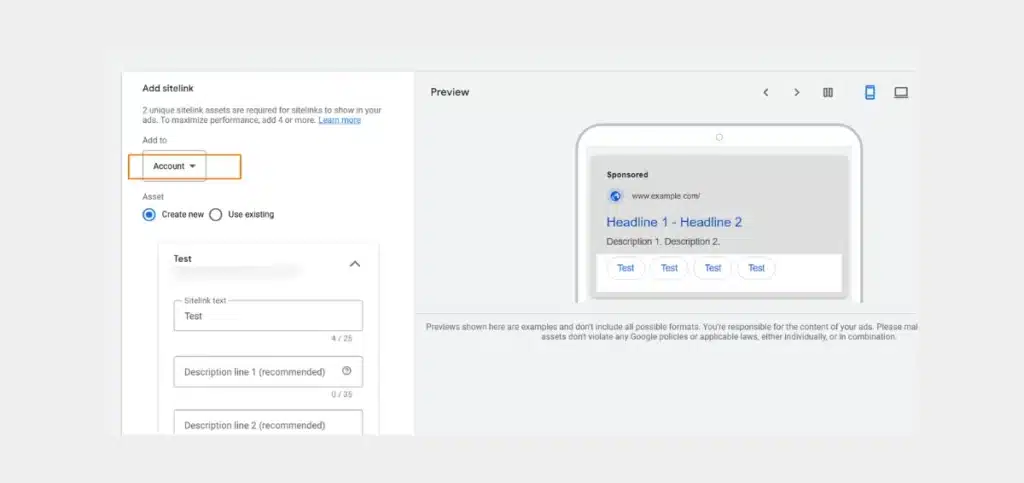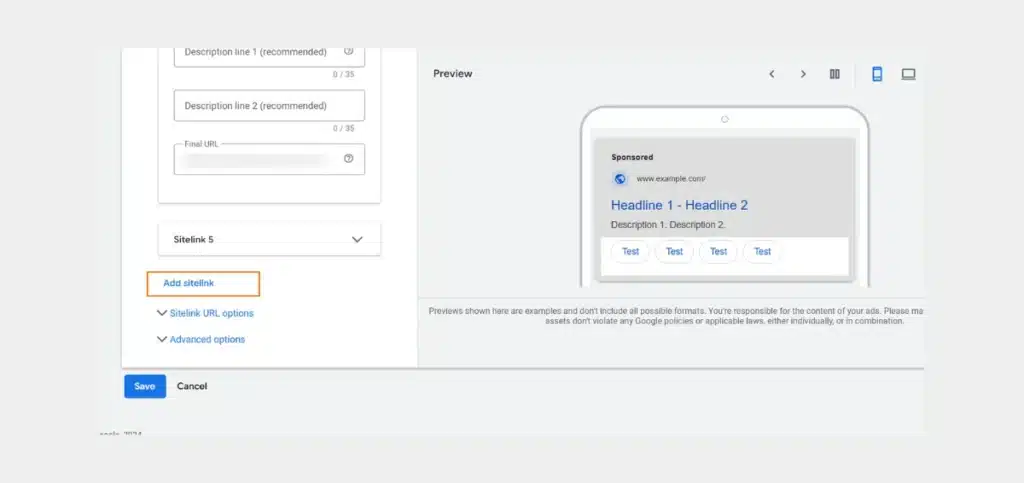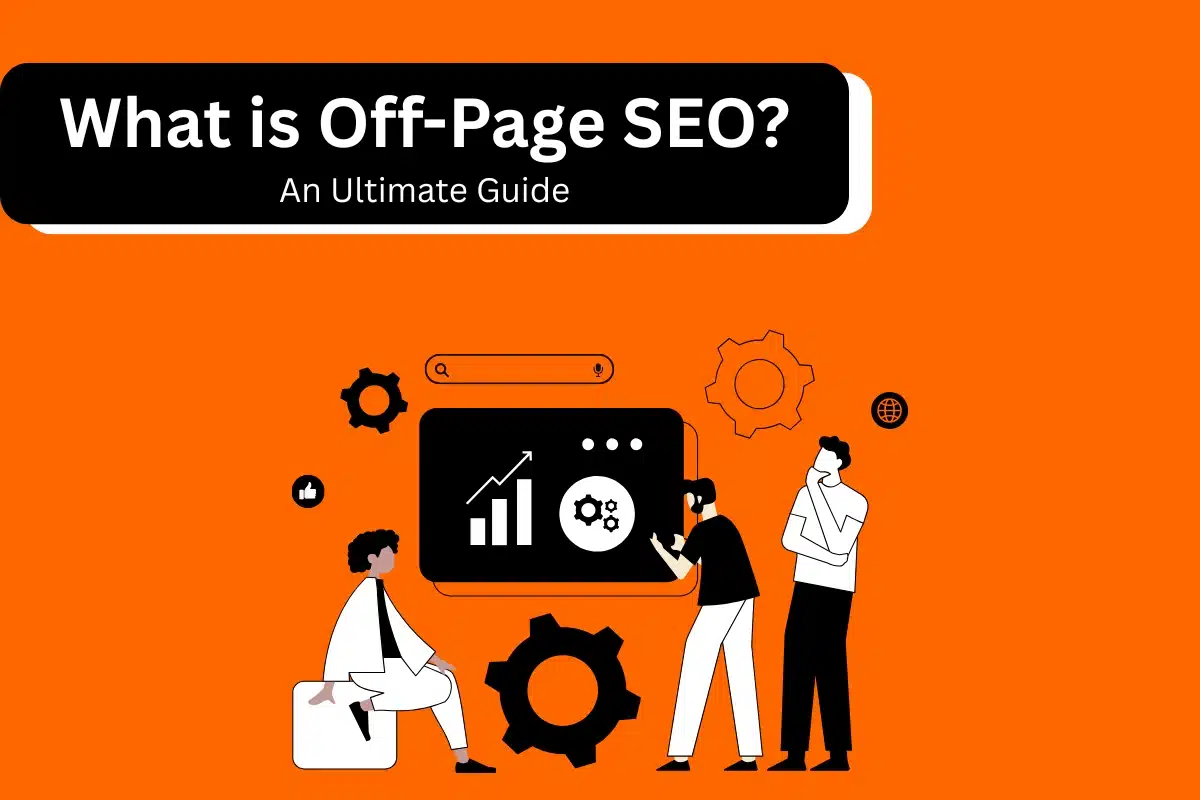It’s that time of the day when you just cannot take another step without a coffee. What do you do? Of course, you search for a local coffee shop online. You see a Google ad and see direct links to “Menu,” “Locations,” and “Special Offers.” It’s like finding exactly what you need without any effort. This is the magic of sitelink extensions in Google Ads.
These clickable links are crucial for the success of businesses. They don’t just enhance the ad’s appeal; they guide potential customers to relevant pages instantly. Do you need to improve engagement or increase clicks? Either way, sitelink extensions can empower your advertising campaigns.
Join me as I take you on a tour through the types of sitelink extensions, their setup, significance, best practices, and more to help you achieve better results. By the end, you’ll know how to utilize them to enhance visibility, improve performance, and achieve business growth.
All set to take your business to the next level? Our Google Ads management services help create relevant sitelink extensions to improve conversions and sales. Try us today!
What are Sitelink Extensions in Google Ads?
Sitelink extensions (currently known as sitelink assets) are additional clickable links that appear beneath your main ad in a Google Ads campaign. These links guide users to specific pages, like “About Us,” “Product Reviews,” or “Contact Us.” They work great in improving ad performance by offering direct links to the most relevant information users need.
For instance, imagine you run a clothing store. Your ad features sitelink assets like “New Arrivals,” “Black Friday Sale,” and “Store Locator.” This setup improves user experience by providing quick access to key sections of your website.
Key Features of Sitelink Extensions
Now that you have an idea of what sitelink assets mean, here are its main features:
- Desktop vs. Mobile Placement: On desktops, they appear as additional links under your ad. On mobile devices, they are more compact but just as effective.
- Clickable and Relevant: Each sitelink leads directly to a specific landing page. This makes them highly user-friendly.
- Enhanced Visibility: Sitelinks increase the size of your ad, making it more noticeable among competitors.
Investing in sitelink extensions doesn’t just improve your ad’s visibility; it also helps drive website traffic and increase click-through rates (CTR).
Curious about how sitelinks can empower your campaigns? Let our Google Ads specialist assist you in getting started!
Types of Sitelink Extensions
Sitelink extensions are more versatile than you think. Did you know these can be customized to different campaign types? Let’s explore two common options:
Search Campaign Sitelinks
If you are planning to run text-based ads in search results, you must check out this option. For example, if you own a hotel, your ad might include sitelinks like “Book a Room,” “Amenities,” and “Reviews.” They enable users to directly browse their preferred section without extra steps.
Video Campaign Sitelinks
These sitelinks are generally used in YouTube ads. While your users engage with your video content, these sitelinks direct them to specific pages. For example, a fitness brand that revolves around workout routines on YouTube might include sitelinks such as “Shop Gear,” “Find a Trainer,” or “Download App.”
These extensions incredibly improve user engagement, in addition to enhancing the relevance of your campaigns.
Choose the right type of sitelink for your campaign to optimize results and keep your audience connected with your brand.
Need help identifying the best sitelink extensions for your business? The Google ads experts at our PPC agency will work with you to help you make the most of your ad campaigns!
Why Should I Add Sitelinks to Google Ads?
The biggest benefit of using sitelink extensions is how they transform your ads into powerful tools for engagement and conversions. Let’s break it down:
- Improve Click-Through Rates (CTR): Sitelinks provide direct access to relevant pages. This makes ads more engaging and increases the chances of user interaction.
- Enhanced User Experience: Sitelinks simplify navigation by offering shortcuts to important pages. This helps your users find what they need more efficiently.
- Flexibility for Promotions: Be smart and use sitelinks to highlight seasonal discounts, new product launches, or limited-time campaigns. Make sure your website gets higher visibility for special offers.
- Improved Ad Rank: Including sitelinks in your ad campaigns is a great way to improve Quality Scores. The presence of sitelinks may also aid in enhancing your ad positioning and outperforming competitors in search results without extra spending.
- Detailed Reporting: Gain actionable insights into individual sitelink performance to refine your ad strategy. Focusing on high-converting sitelinks will help you maximize engagement and ROI.
- More Ad Real Estate: Sitelinks add extra links and descriptions, to make your ad visually larger and more noticeable in crowded search spaces.
- Cost Efficiency: Did you know that sitelinks cost nothing extra? Yes, adding sitelinks does not stretch your ad spend, but can significantly enhance your PPC campaigns. The result? Maximum returns on your advertising budget.
Want to achieve better click rates and conversions? Our Google Ads experts can set up and optimize sitelinks for your business. Get in touch today!
How Do I Add Sitelinks to My Google Ads?
Wondering how to enable sitelinks in Google Ads? Relax! It’s a straightforward process that offers amazing returns. Here’s a step-by-step guide:
- Sign in to your Google Ads account.

- Click on “Assets” and then on the “Assets” section.

- Now click the blue plus (+) icon.

- Choose “Sitelink” from the dropdown menu.

- Next, use the “Add to” option to select the level (account, campaign, or ad group) where your sitelinks should appear.

- Now, fill out the forms to create your sitelink extensions. Remember that the preview shows updates in real-time.

- To add more, click “Add sitelink” and repeat the process.

- When you’re done, hit “Save.”

See? It’s that simple! With your sitelink assets in place, your ads will be ready to drive better engagement.
Need help setting up sitelinks? Let our PPC marketing agency handle it while you focus on your business!
What are Good Sitelinks?
Good sitelinks add impetus to your ad campaign. These sitelinks provide users with clear, direct paths to the most relevant pages on your website. In short, it’s a smart way to enhance both engagement and conversions.
Features of Good Sitelinks
What makes a sitelink truly “good”?
- Relevant to User Queries: Make sure that your sitelinks address common questions or needs, such as “Pricing,” “Services,” or “Special Offers.”
- Action-Oriented Language: Use actionable phrases like “Shop Now” or “Get a Quote” to encourage immediate user interaction.
- Linked to High-Converting Pages: Ensure each sitelink points to a page designed to convert, such as a well-optimized landing page.
Examples of Effective Sitelinks
A few examples of good sitelinks will give you a better idea of how to go about it: Here are some popularly used ones:
- Contact Us: Let users reach out quickly.
- About Us: Perfect for building trust with potential customers.
- Special Offers: Highlight limited-time deals to create urgency.
- Testimonials: Display reviews to build credibility.
Common Mistakes to Avoid
Since sitelinks are easy to create, many businesses end up overlooking crucial aspects that can adversely impact conversions. Here are some instances:
- Linking to broken pages can leave users frustrated and distrustful of your business.
- Using generic or vague sitelink text like “Click Here” may not entice your users to actually take action.
- Including 3-4, sitelinks look fine since users can easily scan through the lot. But, more than that can reduce clarity and even turn away users.
Unsure about the right sitelinks for your business? Consult our Google Ads expert today for expert guidance!
Google Ads Sitelinks Best Practices
To get the most from sitelinks, follow these proven strategies:
1. Be Clear About Your Objectives
Understand your campaign goals. This is vital to ensure that your sitelinks align with your desired outcomes. For instance, if your primary goal is to increase sales, your sitelinks will be totally unlike what they would be if your goal is something else like increasing inquiries.
2. Choose Sitelink Destinations Carefully
If your sitelink says “Offers”, but directs users to the “Contact Us “ page, these users are unlikely to trust you again. So, lead your users to pages that match their intent.
3. Use Sitelinks as Part of Your Larger Strategy
You must ideally have a strong, compelling ad text in place before bringing in sitelink assets. In other words, incorporate them to complement your ad text and reinforce your overall messaging.
4. Use a Mix of Sitelinks
Users will have different intents—while some may be interested in checking out your entire product range, others may be looking for good deals. So, include different sitelinks like “Learn More,” “Pricing,” or “Book a Demo” to cover those diverse user needs.
5. Create Landing Pages for Your Sitelinks
A dedicated page for each sitelink improves relevance and offers users the precise information they are looking for. It also helps improve conversion rates and Quality Scores.
6. Keep the Sitelink Text Short
Well, the reason you choose sitelinks in the first place is to make it easier for users to find pages. So obviously, you don’t have to complicate it with lengthy text. Keep it concise with phrases like “Contact Us” or “Get Started” to make your ad more scannable.
7. Add Sitelink Descriptions
Enhance sitelinks with short descriptions to encourage users to take action. For instance, instead of just “Contact Us”, consider supplementing it with a line like “Reach out for more information.”
8. Enable Dynamic Sitelinks
Google automatically creates and displays dynamic sitelink assets to help users connect directly to your products or the information they are searching for. Turning on dynamic sitelinks further expands your ad’s relevance.
9. Track Sitelink Performance and Adjust
Regularly review data related to various sitelinks to identify which sitelinks drive the most engagement. Keep refining based on these insights to increase clicks.
10. Avoid Generic Links
Imagine a user eagerly clicking through a sitelink that says “Last Day of Sale” only to be led to the homepage. Remember, linking to the homepage or the ‘About Us’ page can dilute the impact. Direct users to specific, valuable pages instead.
Why It’s Better to Use a Mix of Sitelink Assets?
Not all sitelinks perform equally. Which is why using a variety helps you gather actionable insights and optimize performance.
For example, a sitelink like “What is Reiki?” might attract more curious, top-of-funnel users and outperform a more sales-oriented option like “Speak to an Expert” in click-through rate (CTR). While both have value, their effectiveness can vary based on user intent and ad context.
By monitoring performance, you can refine your strategy. If one sitelink underperforms consistently, you can replace it with something more compelling or informative.
This approach enhances engagement in addition to ensuring maximum ad impact across different audience segments.
Want to learn more about how sitelink variety can empower your campaign? Let’s collaborate and make your ads perform better than ever! Contact us today!
Sitelink Assets Examples
Sitelinks are not one-solution-fits-all. The content will vary widely based on the industry and audience. Here are a few examples to get you started:
- E-commerce: Sitelinks like “New Arrivals,” “Sale Items,” or “Track Your Order” help shoppers head directly to what they need.
- Service Industry: Businesses often use sitelinks like “Request a Quote,” “Our Services,” or “Customer Reviews” to showcase expertise and encourage engagement.
- Education: Universities or online course providers use options like “Courses Offered,” “Admission Info,” or “Student Testimonials” to guide potential students.
- Healthcare: Sitelinks such as “Book an Appointment,” “Services We Offer,” or “Insurance Information” make it easy for patients to find key details.
Try these examples to create a better user experience and increase conversions.
How Does Google Choose Sitelinks?
Automated vs. Manual Selection
Google offers two options for sitelinks: manual sitelinks, which advertisers set up directly, and dynamic sitelinks, generated automatically by Google’s algorithm. Google uses dynamic sitelinks when it believes they’ll enhance ad performance. For this, it often pulls relevant links from your website based on user behavior and queries.
Factors Influencing Choice
Google considers several factors when displaying sitelinks:
- Relevance: Are the sitelinks closely related to the user’s query? If yes, there are high chance that your sitelinks will be displayed.
- Ad Rank: If your ad manages to achieve a high ranking, they are more likely to be accompanied by sitelinks.
- Landing Page Quality: Your landing pages must load quickly and provide value to users. If it does so, Google will prioritize your sitelinks.
Tips to Influence Selection
Although you can’t fully control dynamic sitelinks, you can certainly do your share by:
- Optimizing your landing pages for user experience and SEO.
- Aligning sitelinks with the intent of your target audience.
- Using manual sitelinks to showcase high-value pages.
How Do I Create a Sitelink Extension That Works?
Time to explore some proven hacks on how to create sitelink extensions that truly contribute to improving your conversions.
- Create Compelling Sitelinks: This is a great starting point. Focus on action verbs like “Shop,” “Learn,” or “Get Started” to drive clicks.
- Highlight your USPs: Let your users know why they must check out your products or services. Think phrases such as “Free Delivery” or “30-Day Free Trial.”
- Don’t ignore mobile users: Remember that a large chunk of your users will be accessing your site through mobile devices. Use shorter sitelink text to ensure readability on smaller screens. Better still, test how sitelinks look and function across various devices.
- Keep Testing and Improving: Regularly review performance data and refine sitelinks. Replace underperforming links with more relevant options.
Why Aren’t My Google Ads Showing Sitelinks?
If your ads aren’t displaying sitelinks, here are some possible reasons and quick fixes:
- Incorrect Setup: Double-check your campaign settings. Make sure that sitelinks are enabled.
- Sitelinks Aren’t Relevant Enough: Remember how I mentioned that Google prioritizes relevance? If it is an issue of relevance, try updating sitelinks to match user queries.
- Low Ad Position or Ad Rank: Sitelinks will not show up if your ad ranking is low. Try to improve your ad rank by increasing bids or improving ad quality.
- Google Doesn’t See Value in Sitelinks: Do your sitelinks lead to the homepage or other generic pages? Keep in mind that your sitelinks must direct users to high-quality, actionable pages to appear in search results.
Ready to Maximize Your Ad Performance?
Depending on how well you use them, sitelink extensions can be powerful tools to enhance your Google Ads performance. It can also offer better user experiences and create higher engagement. But, creating effective sitelink extensions demands strategy, precision, and ongoing refinement. If you’re unsure of managing it on your own, do not hesitate to reach out for expert help.
Our Google ads services can help you achieve incredible results with impactful sitelink assets—contact us today!






